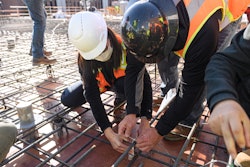The Indiana Department of Transportation (INDOT) tasked a team of Purdue University engineers with collecting data on concrete maturity through select highway patching and paving projects. The team will use the data to provide a new evidence-based recommendation on the optimal time to open up traffic following a construction project, which would save time and reduce traffic slowdowns.
Purdue engineering researchers are collecting data through piezoelectric sensors designed to track concrete strength development in real time through measurements of hydration, stiffness, compressive strength and other properties of concrete. After testing, INDOT plans to adopt the sensors, allowing them to permanently live in highways and continuously keep contractors informed on concrete distress.
“Concrete pavement patching has to achieve a certain strength level to accommodate truck traffic due to the load and pavement curling and warping,” noted Tommy Nantung, the agency’s research and development planning and production manager, in a statement. “Through these sensors, a contractor will know exactly when the concrete is mature enough to accommodate heavy truck loads."
The sensors are protected from corrosion and not easily crushed by construction equipment and the array also allows data to be collected for years after the concrete is laid down.
“Being able to track concrete strength over a longer period of time would help engineers to know if they’ve over- or under-designed roads and better determine when to replace the concrete,” Luna Lu, an associate professor at the university’s Lyles School of Civil Engineering adds.













![Fcp Racatac Chair 10893876[1]](https://img.forconstructionpros.com/mindful/acbm/workspaces/default/uploads/2025/10/fcp-racatac-chair-108938761.10l0At5WXv.png?ar=16%3A9&auto=format%2Ccompress&bg=fff&fill-color=fff&fit=fill&h=135&q=70&w=240)





